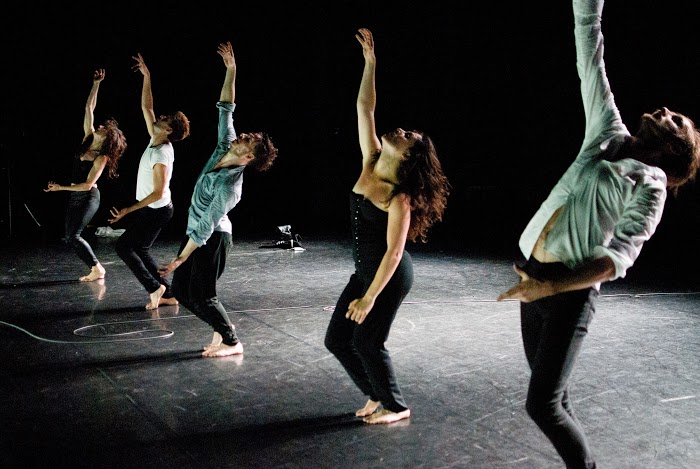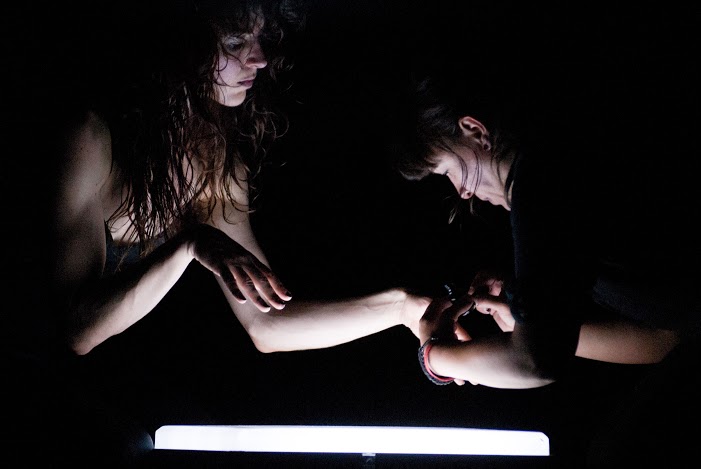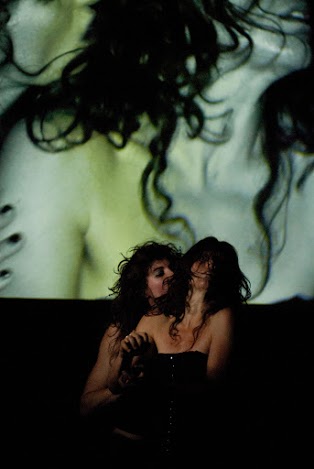The Black Piece or Lost in the Dark
 Even though the motto of the Dance Prague festival warns us that there is no guarantee that our expectations will be fulfilled, it is still possible you will be surprised, to say the least. It is possible if you go to the Dutch performance called The Black Piece by Ann Van den Broek.
At the beginning the author herself steps on a big switch. You are surrounded by darkness; the only lights are small light spots along the edge of the open space in Ponec theatre, shining like stars. There are various sounds – you can hear someone walking and treading, then there’s rustling of paper, a sound of something falling down and the kind of laughter that does not bode well. Darkness persists and there is someone with a camera walking on the stage (during the final discussion you can see Thorsten Alofs, who operated the camera, chased after performers and blinded them with it, on your own eyes). Van den Broek uses a torch to illuminate shoes, trainers, a T-shirt, paper and other things scattered on the stage. She also uses the torch to shed light on what is going on on the stage as otherwise there wouldn’t be much of a spectacle. We need to find meaning and symbols of the black colour in a complete darkness. It is a topic that Vand den Broek, choreographer and former dancer, has been excited by since 2011. Back then she took a creative rest and she decided to focus on colour, which – as she admitted in the debate after the performance – has fascinated her since she was a little girl. She finds black a comforting and agreeable colour but at the same time she is aware of the fact that it raises fear.
Even though the motto of the Dance Prague festival warns us that there is no guarantee that our expectations will be fulfilled, it is still possible you will be surprised, to say the least. It is possible if you go to the Dutch performance called The Black Piece by Ann Van den Broek.
At the beginning the author herself steps on a big switch. You are surrounded by darkness; the only lights are small light spots along the edge of the open space in Ponec theatre, shining like stars. There are various sounds – you can hear someone walking and treading, then there’s rustling of paper, a sound of something falling down and the kind of laughter that does not bode well. Darkness persists and there is someone with a camera walking on the stage (during the final discussion you can see Thorsten Alofs, who operated the camera, chased after performers and blinded them with it, on your own eyes). Van den Broek uses a torch to illuminate shoes, trainers, a T-shirt, paper and other things scattered on the stage. She also uses the torch to shed light on what is going on on the stage as otherwise there wouldn’t be much of a spectacle. We need to find meaning and symbols of the black colour in a complete darkness. It is a topic that Vand den Broek, choreographer and former dancer, has been excited by since 2011. Back then she took a creative rest and she decided to focus on colour, which – as she admitted in the debate after the performance – has fascinated her since she was a little girl. She finds black a comforting and agreeable colour but at the same time she is aware of the fact that it raises fear.
 Performance as a research
A fundamental thing for The Black Piece was a research on how dancers perceive darkness. At first the choreographer let them improvise, she videoed them and asked them to spend as much time as possible in dark and learn what it makes them feel like. Step by step, interprets reflected their emotions in bodily expressions and the structure of the vision appeared. Van den Broek thus obtained the material she needed. As a director she then shortened, edited and adjusted the material to reach several stratified levels. Dancers’ feelings became the basis of the conception of physical expression. However, there are no significant differences between individual dancers. Another source of inspiration was Michael Pastoureau’s book called Black, The History of a Color, dealing with symbolic transformations of black colour in people’s thinking an in the history of the human race.
The introduction was quite lengthy. On the screen we watched details captured by the camera, such as lacquered high heels, a play with black figurines or long gazes of protagonists. Tree “mannequins” are then brought into focus. One of them is toying with lapels of his black leather jacket. His shoulders start moving forward and backward and gentlemen standing behind him take the frequency over. Tosses of head, arms and pelvis repeat, no one communicates with anyone else and the five performers remain captives of their physical case with no chance of finding peace. Not even rhythmical musical accompaniment created by various sounds and vocals. Motion phrasing is not very dynamic and it goes along with the beat. Several times the dancers meet in a row at the front of the stage. All of the sudden the motion aggression gets synchronic only to fall apart again in a while. Nervous trembling of one of the men is interrupted by a small music box, which, supposedly, was a personal object provided by the dancer.
On the edge of madness
Three men and two women that later emerge from the dim (one of them with a moustache and in trousers, the other one in heels, narrow skirt and a white blouse) and return to seclusion, darkness, fears and worries. It seems that everyone is absolutely paralyzed by that, they are not able to break out of motion tics, the convulsion controls them.
Performance as a research
A fundamental thing for The Black Piece was a research on how dancers perceive darkness. At first the choreographer let them improvise, she videoed them and asked them to spend as much time as possible in dark and learn what it makes them feel like. Step by step, interprets reflected their emotions in bodily expressions and the structure of the vision appeared. Van den Broek thus obtained the material she needed. As a director she then shortened, edited and adjusted the material to reach several stratified levels. Dancers’ feelings became the basis of the conception of physical expression. However, there are no significant differences between individual dancers. Another source of inspiration was Michael Pastoureau’s book called Black, The History of a Color, dealing with symbolic transformations of black colour in people’s thinking an in the history of the human race.
The introduction was quite lengthy. On the screen we watched details captured by the camera, such as lacquered high heels, a play with black figurines or long gazes of protagonists. Tree “mannequins” are then brought into focus. One of them is toying with lapels of his black leather jacket. His shoulders start moving forward and backward and gentlemen standing behind him take the frequency over. Tosses of head, arms and pelvis repeat, no one communicates with anyone else and the five performers remain captives of their physical case with no chance of finding peace. Not even rhythmical musical accompaniment created by various sounds and vocals. Motion phrasing is not very dynamic and it goes along with the beat. Several times the dancers meet in a row at the front of the stage. All of the sudden the motion aggression gets synchronic only to fall apart again in a while. Nervous trembling of one of the men is interrupted by a small music box, which, supposedly, was a personal object provided by the dancer.
On the edge of madness
Three men and two women that later emerge from the dim (one of them with a moustache and in trousers, the other one in heels, narrow skirt and a white blouse) and return to seclusion, darkness, fears and worries. It seems that everyone is absolutely paralyzed by that, they are not able to break out of motion tics, the convulsion controls them.
 They are writhing on the floor, waving their arms, pulling faces into the lens and submerging into their bodies that are unable to move. From time to time a sharp light suddenly turns on but immediately the whole space sinks into darkness again. Stage reality is rather gloomy. Dancers do not penetrate through the dark, it is their enemy that drives them to the edge of madness, leaving them frantically flapping to and fro, to and fro…
It is not easy to go and live through this eighty minute physical performance full of fistful gestures – and not only for performers. I felt as if I was watching torments and traumas of a sore human soul. Rather than assessing artistic performance, it would be more suitable to write down a diagnosis to understand it well. Especially if it’s not just the darkness you are getting lost at… (film shots of a child that was supposed to represent hope for getting out of the desperate psychical masochism didn’t help me either).
Written form the performance on 16th June 2016 at Ponec theatre.
Tanec Praha 2016
The Black Piece
They are writhing on the floor, waving their arms, pulling faces into the lens and submerging into their bodies that are unable to move. From time to time a sharp light suddenly turns on but immediately the whole space sinks into darkness again. Stage reality is rather gloomy. Dancers do not penetrate through the dark, it is their enemy that drives them to the edge of madness, leaving them frantically flapping to and fro, to and fro…
It is not easy to go and live through this eighty minute physical performance full of fistful gestures – and not only for performers. I felt as if I was watching torments and traumas of a sore human soul. Rather than assessing artistic performance, it would be more suitable to write down a diagnosis to understand it well. Especially if it’s not just the darkness you are getting lost at… (film shots of a child that was supposed to represent hope for getting out of the desperate psychical masochism didn’t help me either).
Written form the performance on 16th June 2016 at Ponec theatre.
Tanec Praha 2016
The Black PieceChoreography, concept and direction: Ann Van den Broek
Camera: Bernie van Velzen
Life music: Thorsten Alofs
Music composition: Arne Van Dongen
Vocals: Gregory Frateur
Scene: Ann Van den Broek and Bernie van Velzen
Costumes: Ann Van den Broek and Judith Van Herck World premiere: 19th September 2014, Korzo Theater, Haag
Translation: Zuzana Sovová


